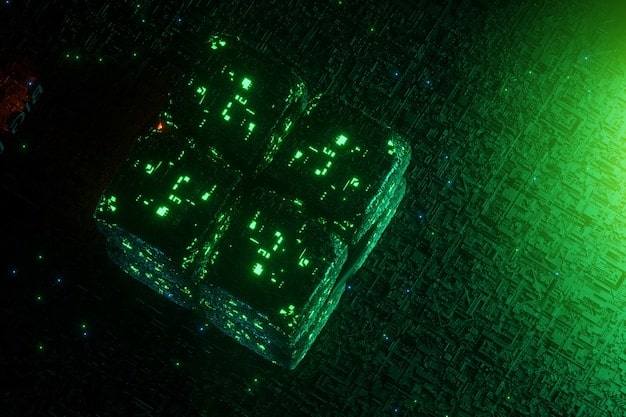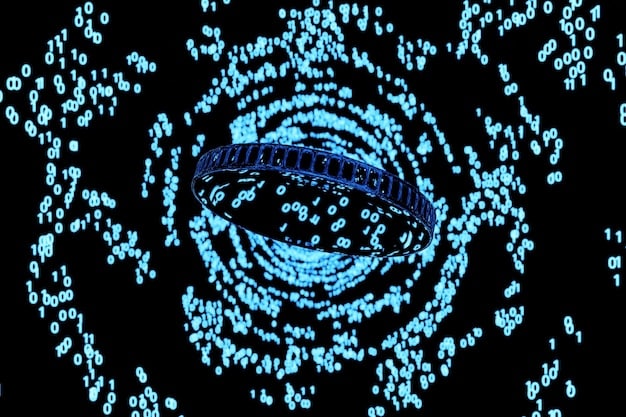The Impact of Quantum Computing on US Data Encryption: A 2025 Update

The Impact of Quantum Computing on US Data Encryption: A 2025 Update reveals the urgent need to upgrade current encryption methods as quantum computers advance, threatening the security of sensitive data across various sectors in the United States.
The rise of quantum computing poses a significant threat to current data encryption methods. This article explores The Impact of Quantum Computing on US Data Encryption: A 2025 Update, focusing on the challenges and opportunities in safeguarding sensitive information.
Understanding the Quantum Computing Threat
Quantum computing, leveraging quantum mechanics, promises exponential increases in processing power compared to classical computers. While offering potential benefits across various fields, this power also threatens existing cryptographic systems, especially in the United States.
The core issue is that many current encryption algorithms, such as RSA and ECC, rely on the computational difficulty of certain mathematical problems. Quantum computers, using algorithms like Shor’s algorithm, can solve these problems much more efficiently, potentially breaking these encryption methods.
Shor’s Algorithm and Encryption Vulnerabilities
Shor’s algorithm, developed by mathematician Peter Shor in 1994, is a quantum algorithm that can factor large numbers exponentially faster than the best-known classical algorithm. Factoring large numbers is the basis for the security of the RSA encryption algorithm, which is widely used for secure communication and data storage.
Quantum Supremacy and Encryption Timelines
Quantum supremacy refers to the point at which a quantum computer can perform a calculation that no classical computer can perform in a reasonable amount of time. While true quantum supremacy is still debated, advancements in quantum computing hardware are steadily progressing, shortening the timeline for when quantum computers could break current encryption.

- RSA and ECC Weaknesses: Analyze standard encryption protocols’ vulnerabilities to quantum attacks.
- Quantum Computing Progress: Highlight advancements in quantum hardware and error correction.
- Forecasting Encryption Risks: Evaluate timelines for potential quantum breaches in the near future.
Therefore, understanding the quantum computing threat is crucial for the United States to prepare and implement new encryption standards to protect sensitive data from potential quantum attacks.
The Current State of US Data Encryption
The United States heavily relies on existing cryptographic standards for data encryption across government, finance, healthcare, and many other sectors. However, the looming threat of quantum computing necessitates a reevaluation of these standards.
Current encryption standards largely depend on algorithms like Advanced Encryption Standard (AES), RSA, and Elliptic Curve Cryptography (ECC). While these algorithms are secure against classical computers, they are vulnerable to attacks from quantum computers.
Federal Encryption Standards and NIST
The National Institute of Standards and Technology (NIST) plays a vital role in setting standards for data encryption in the United States. NIST is currently leading an effort to develop and standardize post-quantum cryptography (PQC) algorithms that are resistant to attacks from both classical and quantum computers.
Commercial Encryption Practices
In the commercial sector, companies use a variety of encryption methods, including AES, RSA, and ECC, for securing data in transit and at rest. However, many organizations are unaware of the potential threat posed by quantum computing and have not yet begun to transition to post-quantum cryptography.
For instance, e-commerce companies use TLS/SSL protocols, which rely on RSA and ECC, to secure online transactions. Healthcare providers use encryption to protect electronic health records (EHRs), and financial institutions use encryption to secure online banking and financial transactions.
- Encryption Reliance: Detail the extent to which US sectors rely on current encryption models.
- Standard Limitations: Describe the acknowledged limits to these standards in relation to rising technology.
- Vulnerable Points: Pinpoint sectors and data types at greatest immediate risk.
Thus, a thorough assessment of the current state of data encryption in the US reveals significant vulnerabilities that need to be addressed with the adoption of post-quantum cryptography.
Post-Quantum Cryptography (PQC) Initiatives
Recognizing the impending threat, the US government, led by NIST, is actively pursuing post-quantum cryptography (PQC) initiatives. These initiatives aim to develop and standardize cryptographic algorithms that are resistant to attacks from both classical and quantum computers.
Post-quantum cryptography focuses on developing algorithms that rely on mathematical problems that are believed to be hard for both classical and quantum computers to solve. These algorithms include lattice-based cryptography, code-based cryptography, multivariate cryptography, and hash-based cryptography.
NIST’s PQC Standardization Process
NIST initiated a multi-round competition to evaluate and standardize post-quantum cryptography algorithms. The process involves public submissions, rigorous testing, and analysis by cybersecurity experts. The goal is to select a set of algorithms that can be used for various applications, including encryption, digital signatures, and key exchange.
Candidate Algorithms and Their Strengths
The NIST PQC standardization process has identified several promising candidate algorithms, each with its own strengths and weaknesses. Lattice-based algorithms, such as CRYSTALS-Kyber and CRYSTALS-Dilithium, are considered to be among the most promising candidates due to their strong security properties and efficient performance.

- Algorithm Candidates: Identify the leading PQC algorithms under consideration.
- NIST Standards Effort: Explain the objectives and process of NIST’s post-quantum standardization.
- Practical Impacts: Discuss challenges to integrating PQC into current infrastructures, including cost.
In conclusion, the post-quantum cryptography initiatives led by NIST are crucial for ensuring the security of data in the United States in the face of the quantum computing threat.
Impact on US Government and Defense
The US government and defense sectors are particularly vulnerable to quantum computing attacks due to the sensitive and classified information they handle. Ensuring the security of this data is critical for national security and defense.
Government agencies and defense contractors rely on encryption to protect communications, data storage, and critical infrastructure. The potential for quantum computers to break these encryption methods poses a significant risk to national security.
Classified Data Protection
Classified data, including intelligence reports, military plans, and diplomatic communications, must be protected from unauthorized access. Quantum computers could potentially decrypt this data, compromising national security interests.
Military Communications and Operations
Secure communication is essential for military operations. Quantum computers could intercept and decrypt military communications, potentially giving adversaries a strategic advantage. Post-quantum cryptography is crucial for securing military communications and ensuring the effectiveness of military operations.
Defense systems, such as missile control systems and drone control systems, rely on encryption to prevent unauthorized access and control. Quantum computers could potentially compromise these systems, leading to catastrophic consequences.
The US government and defense sectors need to accelerate the adoption of post-quantum cryptography to protect classified data, secure military communications, and ensure the integrity of defense systems. This requires proactive measures, including research and development, standardization, and deployment of post-quantum cryptographic solutions.
Economic Implications for US Businesses
The rise of quantum computing also has significant economic implications for US businesses. Companies in various sectors, including finance, healthcare, and technology, need to protect their data from quantum attacks to maintain competitiveness and avoid financial losses.
Data breaches caused by quantum computers could lead to significant financial losses for US businesses. Companies could face fines, lawsuits, and reputational damage. Protecting data from quantum attacks is therefore essential for maintaining financial stability and competitiveness.
Financial Sector Vulnerabilities
Financial institutions rely on encryption to secure online banking, financial transactions, and customer data. Quantum computers could potentially break this encryption, leading to fraud, identity theft, and financial losses. Post-quantum cryptography is crucial for securing financial systems and protecting customer data.
Healthcare Data Security
Healthcare providers use encryption to protect electronic health records (EHRs) and patient data. Quantum computers could potentially compromise this data, leading to privacy breaches and medical identity theft. HIPAA regulations require healthcare providers to protect patient data, and post-quantum cryptography is crucial for meeting these requirements.
US businesses need to assess their current encryption practices, identify vulnerabilities to quantum attacks, and transition to post-quantum cryptography. This requires investment in research and development, deployment of post-quantum cryptographic solutions, and employee training.
Preparing for 2025: Practical Steps
As we approach 2025, it is essential to take practical steps to prepare for the impact of quantum computing on US data encryption. This includes assessing risks, updating encryption protocols, and educating stakeholders.
The first step is to assess the risk posed by quantum computing to existing encryption methods. This involves identifying the types of data that need to be protected, the encryption methods currently used, and the potential impact of a quantum attack. Organizations should prioritize data that is highly sensitive or has a long shelf life.
Risk Assessment and Prioritization
Risk assessment is a crucial step in preparing for the quantum threat. Organizations need to identify their most valuable assets and data, assess the potential impact of a quantum attack, and prioritize their efforts accordingly.
Updating Encryption Protocols
Updating encryption protocols is another essential step. Organizations should begin to transition to post-quantum cryptography algorithms as they become standardized by NIST. This may involve replacing existing encryption libraries and hardware.
Stakeholder education is also important. This includes educating employees, customers, and partners about the quantum threat and the steps being taken to mitigate it. Raising awareness can help build support for the transition to post-quantum cryptography.
- Risk Evaluation: Assess data at greatest risk.
- Updating Protocols: How to prepare now for quantum-resistant infrastructure.
- Education Initiatives: Educating users and stakeholders about future encryption standards and best practices.
Therefore, by taking practical steps such as risk assessment, updating encryption protocols, and educating stakeholders, the US can prepare for the impact of quantum computing on data encryption and ensure the security of its data in the years to come.
| Key Point | Brief Description |
|---|---|
| 🔒 Quantum Threat | Quantum computers can break current encryption algorithms. |
| 🛡️ Post-Quantum Crypto | NIST is standardizing algorithms resistant to quantum attacks. |
| 🏛️ Government Impact | Critical for national security and defense systems. |
| 💼 Business Risks | Financial and healthcare sectors need to secure data. |
Frequently Asked Questions
▼
Quantum computing utilizes quantum mechanics to perform complex calculations much faster than classical computers, potentially breaking current encryption algorithms. This poses a significant threat to sensitive data across various sectors.
▼
PQC refers to cryptographic algorithms designed to resist attacks from both classical and quantum computers. These algorithms rely on mathematical problems that are believed to be hard for both types of computers to solve, ensuring data security.
▼
NIST (National Institute of Standards and Technology) is leading a multi-round competition to evaluate and standardize PQC algorithms in the United States. This effort aims to select secure and efficient algorithms for various applications.
▼
Sectors handling sensitive data, such as government, defense, finance, and healthcare, are particularly vulnerable. These sectors rely heavily on encryption to protect classified and personal information from unauthorized access.
▼
Organizations should assess their current encryption methods, identify vulnerabilities, update encryption protocols with PQC algorithms, and educate stakeholders about the quantum threat. Proactive risk assessment and mitigation are crucial.
Conclusion
In conclusion, the potential impact of quantum computing on US data encryption is a serious concern that demands immediate attention. By understanding the threats, pursuing post-quantum cryptography initiatives, and taking proactive steps, the United States can safeguard its data and maintain its competitive edge in the face of this technological revolution.





